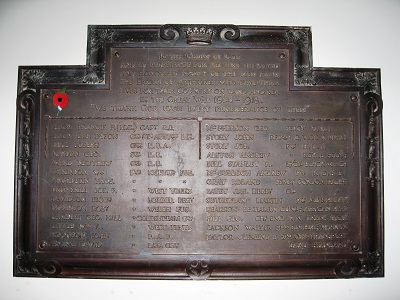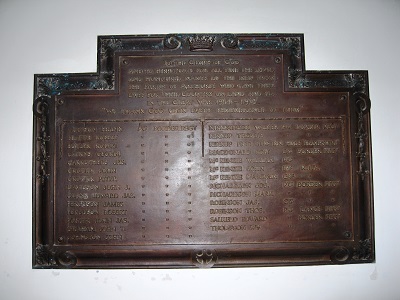St Michael's Arthuret GRID REF: NY39768 67663 Postcode CA6 5SG

ARTHURET CHURCH WW1 MEMORIAL (NORTH)

The churchyard of the parish Church of St Michael at Arthuret is an ancient and interesting burial ground. It is interesting not only for its antiquity but for its links with the history and legend of the Borders.
The most striking feature however for those researching the events of 1914 to 1918 is the large number of reminders within the churchyard, of the effect of the Great War on such communities
Many of the gravestones, some barely legible, bear simple tribute to a husband, son, or grandson whose remains lie far from this peaceful burial ground. That distant grave, in many cases not even identified, would invariably be in a far-away country which those who placed the tribute could never hope to visit. Some of those private memorials commemorate two, and sometimes three, sons of one family.
One such family grave which name a relative whose remains lie in a foreign land is that of the Hodgson family. Air Mechanic John Hodgson, whose decendants still live in the Longton and Gretna area, died in a military hospital in France on 24th of June 1918 at the age of 34. He is interred in Les Baragues Military Cemetery at Sangatte, near Calais. Although a grocer by trade he had adapted his skills to become a part of the new technology of the Royal Air Force. John was the son of Robert and Jane Hodgson, and the husband of Margaret Hodgson, of Bank Street, Longtown. John's son, William Earl Hodgson, died while a POW of the Japanese during WW2. He is interred in Myanmar,near the line of the Burma Railway.
Some private gravestones hold the last remains of a loved son or husband brought home severely injured who unfortunately succumbed to his wounds at some later date. Only by being diligent will the passing stranger notice these.
Some graves, obvious by their classic Commonwealth War Graves Portland stone markers, tell us that a number of the unfortunate wounded reached medical aid in one of the nearby military hospitals. But despite the best efforts of medicine of the time, they could not be saved.
Some may wonder why this period in particular prompted so many personal messages on family gravestones. In earlier conflicts the “poor common soldier” rarely received a mention. His family in fact might never know his fate. Only the wealthy and influential would have “memorials”.
However the Great War was a “people’s war”. The families of even the poorest of the nation felt that the contribution of their lost relative had a value. But public memorials to the ordinary man were unusual. And so it became the custom in the early years of the war (when the concept of community “War Memorials” was not fully developed) to commemorate a loved one in this way.
The Roll of Honour within St Michael’s Church at Arthuret bears the names of fifty-four brave souls of the district who did not survive the Great War. Some lived and suffered long enough to be brought home to die. You will find a number of them interred in this churchyard.
Please take time to walk around and visit a few of their resting places and memorials.
The family grave of Malcolm and Agnes McKenzie, of Moor Cottage, Longtown. Mr and Mrs McKenzie lost three sons to the War. One is interred here, having been returned to the UK severely wounded, only to die in hospital. His two brothers lie far away in battlefield graves.
